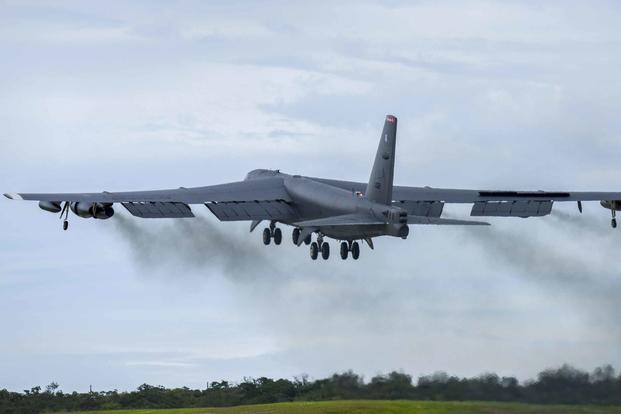The B-52 Stratofortress will no longer carry the B61-7 and B83-1 nuclear gravity bombs as it prepares to carry the new long-range standoff weapon, known as LRSO.
Following reports that the bomb variants had been removed from the Cold War-era aircraft's inventory, officials at Air Force Global Strike Command confirmed the move is in line with the bomber's transition into an era of modern warfare.
"As the nature of modern warfare has changed, so have our tactics and weapons," a command spokesperson said in an email Thursday. "The B-52 remains an instrument of national security and a universally recognized symbol of American airpower, able to deliver the widest variety of stand-off and direct-attack nuclear and conventional weapons for the nation."
"As a multi-role platform, the B-52 offers diverse capabilities including delivery of the most advanced precision-guided weapons. The Air Launched Cruise Missile (ALCM) continues to be our main nuclear deterrent. As such, as a natural progression in the development of the airframe, B-52 crews do not currently train to employ the B83 and B61," the command said.
Related: With B-1 Aging and B-21 Still Years Out, Air Force May Soon Have No Go-To Bomber
Hans Kristensen, director of the nuclear information project at the Federation of American Scientists, first pointed out the change, which went into effect in September, according to Air Force Instruction 91-111, "Safety Rules for U.S. Strategic Bomber Aircraft."
"It's official: B-52 bombers are no longer authorized to carry nuclear gravity bombs," Kristensen said in a tweet earlier this week. "New Air Force instruction describes 'removal of B61-7 and B83-1 from B-52H approved weapons configuration.'"
Command officials pointed out that the move actually preceded the AFI.
"The removal of nuclear gravity weapons like the B-61 and B-83 from the B-52 platform has been in effect for several years," said Justin Oakes, public affairs director for the Eighth Air Force and Joint-Global Strike Operations Center.
"The B-52 remains the premier stand-off weapons platform utilizing the air-launched cruise missile as the main nuclear deterrent. While B61s and B83s are no longer equipped on the B-52, the weapons remain in the [B-2 Spirit] inventory," he added.
Eventually, the LRSO -- a nuclear cruise missile that provides an air-launched capability as part of the nuclear triad -- will replace the AGM-86B ALCM, developed in the early 1980s.
The command said the LRSO, expected by the early 2030s, is one of many investments to keep the B-52, known as the Big Ugly Fat Fellow, flying into the foreseeable future.
For example, the Air Force has already said the B-52 will fly well into the 2050s and perhaps beyond, and will receive upgrades to enhance the aircraft as a whole.
In June, the service ran the first test flight for the AGM-183A Air Launched Rapid Response Weapon (known as "Arrow"), a hypersonic weapon Lockheed Martin Corp. says it will continue to ground and flight test over the next three years. The initial tests done on the B-52 at Edwards Air Force Base, California, were meant to measure performance of the carriage bay on the aircraft, officials said at the time.
Additionally, the Air Force needs brand-new engines for the 75-aircraft fleet, though it's unclear whether all B-52s will receive them.
Each aircraft currently has eight Pratt & Whitney TF33-P-3/103 turbofan engines.
The service estimates it will spend more than $1.3 billion on that project alone over the next five years, according to the Future Years Defense Program assessment.
While the Air Force wants to get new engines for its heavy bombers as quickly as possible, lawmakers are insisting that service officials nail down contract specifics before they provide funding, according to language in the fiscal 2020 National Defense Authorization Act.
The last B-52 rolled off the production line in 1962.
-- Oriana Pawlyk can be reached at oriana.pawlyk@military.com. Follow her on Twitter at @Oriana0214.
Read more: After Military Social Media Flubs, 4-Star Promises Improvements











